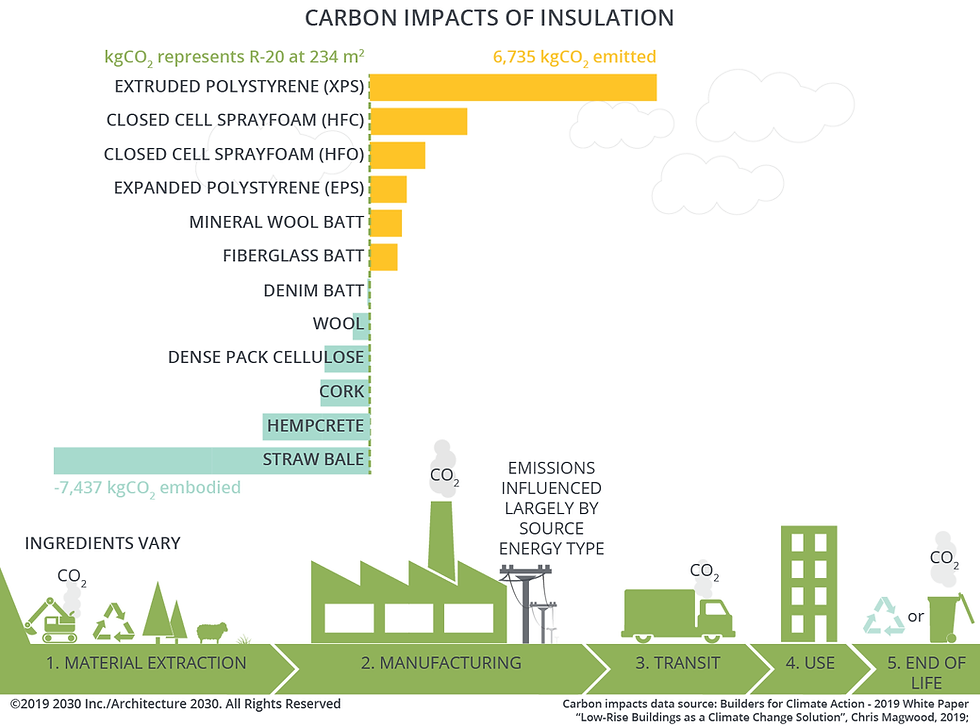THE CONSTRUCTION SECTOR AND ITS IMPACT ON THE ENVIRONMENT
- Miradex Team

- Jul 28, 2021
- 3 min read
How can a building’s carbon footprint be reduced by using natural building materials?
The buildings sector and climate change
The buildings sector has a significant impact on the environment (40% energy consumption and 36% CO2 emissions) and it has been one of European Union’s priorities for some time, EU which has issued directives and has set ambitious goals for future years. Maybe one of the best known directives is directive 844/2018 which raises the question of nZEB (nearly Zero Energy Buildings), namely those nearly zero energy buildings that will be mandatory starting from next year.
Why is this so important? The European Union committed to becoming neutral, by 2050, concerning the environmental impact, thus reducing carbon emissions to 0 in every industry. A very ambitious plan indeed.
Our lifestyle and our daily activities have an effect on the environment: we drive our cars to work, we use fuel to generate electricity or heat for our houses, we use resources to produce assets and building materials and the list continues. All these need energy, which we mainly produce from conventional sources (we use coal, gas, petrol) that liberate CO2 into the atmosphere and lead to climate changes that will make the planet harder and harder to live on ( extreme seasons, prolonged drought, floods due to the rise in ocean levels and melting of the glaciers). See what the consequences are in this video.
With the building sector that takes almost half of the total energy and liberates more than a third of the CO2 emissions, it is very important to understand how the building’s environmental impact can be reduced.
A building’s carbon footprint
It accounts for the total amount of greenhouse gases (CO2, CH4, N20, O3 etc) produced by a building during its life-span and it includes the associated carbon emissions with:
1) energy consumption ( the incorporated energy) necessary for the building’s material’s manufacturing (extraction of raw materials, processing and production, transport etc)
2) energy consumption necessary for the maintenance and operating of a building ( electricity, heating, air-conditioning etc)
As an order of magnitude, a conventional brickwork house has got between 50 and 80 t of CO2 incorporated only for building ( between 50 and 80 t of CO2 have been emitted into the atmosphere for the production, transport of materials and the building of the house per se).

The graph below shows the main building materials and the associated carbon dioxide emissions measured in kg/CO2/tone of material. However, it is important that we also take into account each material’s density ( wood’s density is 800 kg/ square meter as opposed to concrete 2400 kg/ square meter or metal 7850 kg/ square meter) because a wooden house is 3 times more lightweight than a concrete house, therefore the CO2 emissions are 3 times lower only for the same volume.
If you are wondering how wood can replace concrete in multi-storey buildings, well Norwegians have achieved the impossible and they have built the first sky-scraper made entirely of wood.
Ecological building materials
Wood, on the other hand, has a negative carbon footprint because it is a natural material that absorbs CO2 from the atmosphere through photosynthesis and stores it in its structure, as opposed to brick or concrete that require significant amounts of energy in order to be produced. Basically, a wooden house stores the carbon dioxide from the atmosphere in its structure.
Another important component in a house is thermal insulation, that plays a crucial role not only in increasing the thermal performance of the building, (which I have discussed in this article), but also in its carbon footprint.

The graph above shows how thermo-insulating natural organic materials ( such as cellulose, cork, hemp or straw) have a negative carbon footprint, because such as wood, they absorb carbon from the atmosphere through photosynthesis and use it for growth. This phenomenon is known as “carbon sequestration” and a house built with natural materials becomes a “carbon deposit”, namely building materials store in their structure more CO2 than that emitted during its building.
Conclusion
Climate changes and so do building requirements of future buildings, that need to ensure the comfort necessary to residents with minimal power and environmental impact. Globally, more and more efforts are made in order to develop new technologies, building materials and energy from renewable sources capture systems in order to reduce power consumption and CO2 emissions associated with the building sector. We do the same , we continue to invest in resources for developing new constructive energy efficient systems that have a low carbon footprint.
Article written in collaboration with Nidus Home









Comments